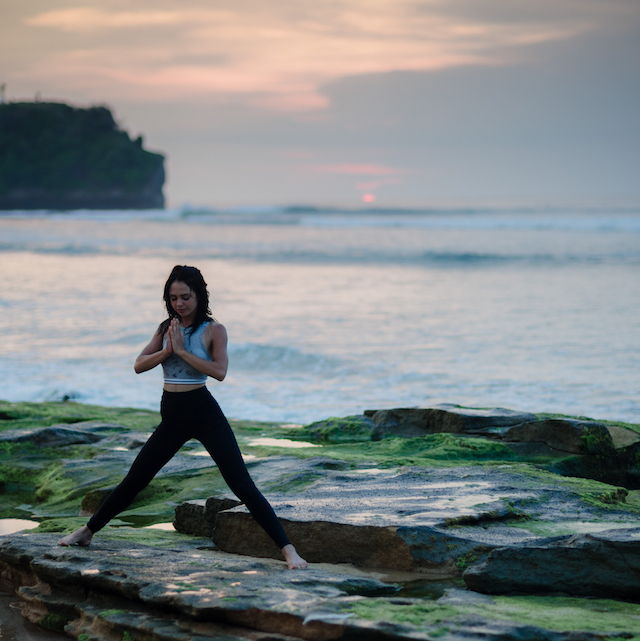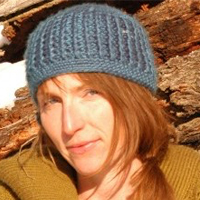
Here’s my dirty little secret: I like my yoga free from a studio, and well—dirty.
Literally dirty. Out in nature, toes in the mud, head to the sky, arms wrapped around a tree—that kind of dirty. The kind of dirty that rocks me to my core.
I kept this a secret because I was always taught that yoga was about postures and how deep we could physically get into them. My home practice was never like that. It was about my relationship with the wild.
I didn’t share this truth often. I felt like it wasn’t a “real” yoga practice. The few times I did open up about it, teachers responded saying, “Nature is a distraction,” or “That’s why you’ll never be a good yoga teacher, you like being outside too much.” Focused practice was limited to a studio, or at the very least, inside. Period.
Sure, there are Instagram pictures of people doing postures on the beach, but the focus is always on the posture, not the natural landscape. Yoga for these people is about the physical body, but as I came to love “getting dirty” with my practice, I learned that what’s outside ourselves is just as valuable as what’s happening inside the body.
So here are six things I’ve learned by getting wild, dirty, and natural in yoga:
1. Inner posture is more valuable than physical posture.
I was never taught about inner posture. The most anyone ever said was, “Be like a mountain. Be like a tree.” I conjured up stories about what a mountain might be like. I had never taken the time to actually contemplate what a mountain might feel like. I would just be there in class standing as strong as I could. I made a story about mountains without actually knowing them.
That is, until one day, when I actually went outside and interacted with a mountain. I wanted to personally understand Mountain Pose. To me, it had little to do with standing on two feet with an elongated spine. Mountains aren’t static. They change over the years and their beauty is in their rugged edges.
As my definition of asana (physical practice) deepens, my sensitivity to the textures that arise from sitting with something has deepened as well. I’ve gained the ability to be still with the natural world and gather insight and awareness from it.
Mountain and Tree Pose aren’t about taking on the associated shape, they’re about going out and understanding, in the moment, what it’s like to be with a mountain or a tree, and then embody that relationship. The posture arises from our understanding, not the other way around. Taking on the posture then cycles back for even further understanding. Without personal experience of these natural wonders, our practice will always be just another story.
2. We must root our practice in something larger or risk becoming self-centric.
Building awareness by sensing our bodies and breath is extremely valuable. It is where we all begin and is a great first step for a lifelong way of being. Eventually, though, our practices must be rooted in the awareness of something greater than our individual selves.
Connecting with nature allows us to focus on something bigger. Something real in the moment. Something we can directly experience outside of our limited, human way of doing things. Nature offers this kind of connection and broadens our awareness. Practicing with nature keeps the session from becoming only about ourselves.
Yoga, after all, calms and transforms our minds’ patterned ways. What better way to do so than immersing ourselves with nature, which already has that ability? Practicing with nature is an act of radicalism—radical acts cause fundamental change.
Humans have the tendency to bond with what’s familiar to us, so sadly most humans won’t interact with nature on a daily basis. Many of us consider nature as merely a resource to capitalize on, something for our recreational pleasure, not something we are inherently a part of.
3. There’s a relationship with nature to be had.
Humans protect what they value and what they believe supports them. We bond with who or what we spend time with and what we understand. Once I truly understood this, I could see how spending my time inside only reinforced the story that nature is something to be conquered and overlooked, rather than honored and consulted.
By bringing my practice of yoga in deeper contact with nature, I began to profoundly understand my place in the family of living things.
4. There is power in asking permission.
Someone recently said to me, “It’s better to beg forgiveness than ask for permission.” I’ve heard this many times but never felt right about it. To me, this phrase encapsulates the very essence of what’s wrong with our society’s interaction with nature, our bodies, and each other.
Many go into nature and do whatever they want, regardless of what’s best for our environment. They are oblivious to the other beings existing among them. The self-centric perspective reveals itself again.
My own understanding of permission really hit home when I experienced how nature’s other beings “ask” permission to interact with me. A stand-out example of this was when a baby robin came to visit me. He was chirping at my door loudly for an extended period of time. When I opened the door, there he was, all feather-fluffed, chirping at me to get my attention. Eventually, I knelt on the ground with him and he came closer, allowing me to stroke his head. We stayed there together over an hour, with Momma Robin watching close by.
In this moment, I got closer to a wild creature than ever before. It felt clean and beautiful. I had only taken what was given freely to me, and in doing so there was no harm. In fact, that robin stayed close to my home for the whole summer and I’m pretty sure he returned the next year. We created a natural bond and relationship.
5. There is integrity in being part of the whole.
Balancing being an individual with being a supportive part of a community is something I see missing from the majority of our culture—even in yoga. For me, this is because we haven’t come to understand what it means to be part of the larger whole. We don’t understand how our actions have consequences that affect all other beings.
As a teacher in a small town, I’ve seen many things I would consider to be the opposite of the yogic mentality. I’ve realized that most yoga teachers, although deeply wanting community, don’t innately understand what it means. I see this when a teacher offers a unique and insightful course or class, and then another teacher is inspired to take it on for themselves without checking-in with the original offerer. Doing so usurps something unique and valuable to the originator. We must consider if our actions compromise the well-being of another, and choose wisely.
6. Abundance is about balance.
Abundance (and a healthy community, for that matter) doesn’t mean we each get to do what we want whenever we want. It doesn’t mean that there’s enough to go around just because we think there should be. This is what happens when our practices become about our individual selves. We think we’re entitled to unlimited resources.
Natural abundance exists in cycles and seasons of release and creation. It honors the diversity of its members, and the resilience of communication. The idea that abundance is linear and parallels the story of our economy is one that isn’t based on our reality and connection with nature.
Healthy community thrives when we are aware and awake enough to support others by respecting their space, gaining permission to recreate what we find inspiring, and remembering that we are connected to the greater whole.
Balance isn’t between two things, it’s between everything. Spending time in nature reveals this clearly.
There’s much more that I have learned from aligning my practice with nature rather than solely my spine.
Each time I sit, breathing in the forest, I am reminded of how much more alive, integral, and organic my practice (and ultimately my being) is. Practicing outside has gradually become intimate and deeply fulfilling for me—much more internally rich than anything inside four walls. Once I set my yoga free and released it back into the wild, I learned what it meant to truly be alive.
In mountain pose, I found vestiges of nature connection woven into yoga from my session’s first pose. From practicing sun salutations, to the names of postures, to visiting deeply secluded monasteries, I know now how nature is implicit to a true yoga practice.
Connecting, or yoking, our yoga techniques with nature is so much more than doing tree pose on a tree stump. Yoga in nature takes on a whole new depth, awareness, wisdom, and insight.
Set your practice free. Get dirty. It’s only natural.
~
~
~
Author: Natalie Forrest
Image: Unsplash / Bady QB
Editor: Danielle Beutell






Read 7 comments and reply